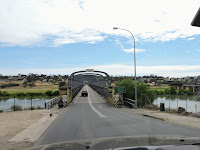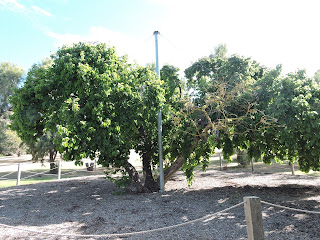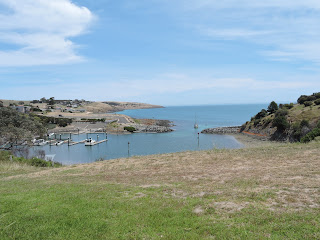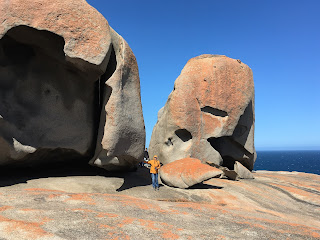We left Kangaroo Island on Thursday, 9 Dec, and we wanted to be back at home on Tuesday, 14 Dec. So we had 5 days for the trip, about 1500 kms, a comfortable 300 km drive for each day, leaving some time for resting and enjoying the surroundings.
 |
| Strathalbyn - Soldiers Memorial Gardens |
 |
| Strathalbyn |
 |
| The old Murray bridge |
Our camping guide book showed one such place near Robinvale, at Walshs Bend. 2 km dirt track led to the water, and the site was indeed pretty nice, only a bit dusty and dry. We spent a pleasant evening here sitting at the water's edge, reading and enjoying the scenery.
 |
| The Murray at Walshs Bend, and the tree where the fire started |
 |
| Here we did not know yet what's coming... |
We went back to bed, but could not sleep. Came out again after half an hour, and again, the roots were alight again. We did a second round of dousing, more water, but it was impossible to reach the back of that hole. The earth around the roots was quite hot, it must have been going on for a long time, only we could not see it in daylight.
Finally we got back to sleep, and there were no more incidents. In the morning, smoke still came out of the hole, but it looked like we managed to get the fire under control. But we were happy to leave that place without any damage.
 |
| Morning calm on the river |
 |
| Our campsite at Nyah |
 |
| The Pevensey at Echuca |
 |
| Cobram in the afternoon - staying in the shade of the tree |
 |
| Breakfast at Cobram |
 From Cobram, we turned North, crossed the Murray river and arrived back to New South Wales. We followed the Newell Hwy crossing Jerilderie then Narrandera. This is the Riverina, an important agricultural region, flat as a tabletop. On the two sides of the road wheat and other grain fields, alternated with grassy paddocks, cattle or sheep grazing. In every little village we saw large silos for grain storage beside a railway line.
From Cobram, we turned North, crossed the Murray river and arrived back to New South Wales. We followed the Newell Hwy crossing Jerilderie then Narrandera. This is the Riverina, an important agricultural region, flat as a tabletop. On the two sides of the road wheat and other grain fields, alternated with grassy paddocks, cattle or sheep grazing. In every little village we saw large silos for grain storage beside a railway line. After Narrandera we turned East, and spent the last night at the Bethungra Dam. The dirt road leading up to the dam passes between the very high pylons of the unique rail spiral loop built in 1940 to reduce the uphill grade for this important rail line. The water level was very low in the dam, surrounded by large open fields with a few fellow campers and cattle grazing on the short grass. It was another pleasant campsite.
 |
| Bethungra Dam |
On Tuesday, 14 Oct, we left after breakfast, and soon reached the Hume Hwy near Gundagai. From here, it was a quick and easy trip back home with a lunch stop near Marulan.
That was the end of another interesting, pleasant and successful tour. We travelled 4,634 kms in 27 days and the average fuel consumption of our new car was 12.2 l/100 km, about one litre less than the old one - a good result.
More photos can bee seen here.
----------------------
Csütörtökön, nov. 9.-én jöttünk el a Kenguru szigetről, és 14.-én otthon akartunk lenni. Tehát 5 napunk volt a hazaútra, ami kb. 1500 km. Átlag 300 km vezetés mellett még volt idő minden nap egy kicsit pihenni és nézelődni is.
 |
| Strathalbyn, anglikán templom |
 |
| Strathalbyn, hősi emlékmű |
 |
| A régi híd a Murray folyón |
Másnap átkeltünk a Murray folyón a Murray Bridge nevű településnél, és a Malley főutat követve hamarosan visszaértünk Victoria államba. Egy Murrayville nevű kisvárosban álltunk meg ebédelni - ami egyébként jó messze van a Murray folyótól, de ezen a vidéken minden arról van elnevezve - aztán Ouyen-nél északra fordultunk. Nem ez a legrövidebb út Sydney-be, de bőven volt időnk, és az estéket a Murray folyó menti kellemes szabad táborhelyeken akartuk tölteni, amiből elég sok van.
A kemping könyvünkből kinéztünk egy ilyen helyet Robinvale mellett egy Walshs Bend nevű folyó-kanyarulatban. Két km földúton lejutottunk a vizpartra és találtunk is egy elég jó helyet, csak kicsit poros és száraz volt. Délután a vízparton üldögéltünk, pihentünk, élveztük a tájat.
 |
| A folyó és az ominózus fa Walshs Bend-nél |
 |
| A kék pöttynél táboroztunk |
Visszamentünk lefeküdni, de aludni nem tudtunk. Fél óra múlva ujra kimentünk megnézni, és a lyuk megint izzott-lángolt. Megint meglocsoltuk még jobban, amennyire tudtuk, de a lyuk mélyére nem nagyon értünk el. A gyökérzet körül a föld is egész forró volt. Ez a tűz nyilván már jóideje izzott a gyökérzet belsejében, csak nem láttuk a füstöt nappali fényben.
Végül csak lefeküdtünk, és az éj további része elmúlt baj nélkül. Reggel a lyuk még mindig füstölt, de úgy látszott, sikerült megfékezni a tüzet. Azért örömmel indultunk tovább erről a helyről.
 |
| Hajnal a folyón |
 |
| Az ügető pálya |
Vasárnap, nov. 12.-én, folytattuk az utat dél-kelet felé a Murray Valley úton. Ez a vidék tele van kisebb-nagyobb tavakkal, amiket a Murray folyó kanyargó medre hagyott hátra. Az egyik nagyobb, Lake Boga, itt megálltunk kicsit pihenni, aztán Cohuna-ban ebédeltünk.
 |
| A Pevensey lapátkerekes |
 |
| Cobram, naplemente után |
 |
| Reggeli a szabadban |
 Cobram-tól észak felé fordultunk, átkeltünk a Murray folyón és visszaérkeztünk New South Wales államba. A Newell főútat követtük, Jerilderie és Narrandera városokon keresztül. Ez az ún. Riverina régió, fontos mezőgazdasági terület. Az út két oldalán búza- és más gabona-táblák váltakoztak föves legelőkkel, sok legelésző tehenet, juhot láttunk. Minden kis faluban hatalmas gabonatároló silók állnak a vasútvonal mellett.
Cobram-tól észak felé fordultunk, átkeltünk a Murray folyón és visszaérkeztünk New South Wales államba. A Newell főútat követtük, Jerilderie és Narrandera városokon keresztül. Ez az ún. Riverina régió, fontos mezőgazdasági terület. Az út két oldalán búza- és más gabona-táblák váltakoztak föves legelőkkel, sok legelésző tehenet, juhot láttunk. Minden kis faluban hatalmas gabonatároló silók állnak a vasútvonal mellett. |
| A spirál-vasút hídja alatt |
 |
| Bethungra víztározó mellett |
Kedden, nov. 14.-én reggeli után tovább indultunk, és hamarosan elértük a Hume autóutat Gundagai mellett. Innen már gyorsan lehetett haladni, és egy rövid ebéd-pihenővel Marulan mellett, koradélután hazaértünk.
Ez a túránk is érdekes és élvezetes volt, minden baj nélkül. Összesen 4634 km-t utaztunk 27 nap alatt, és az autónk átlag-fogyasztása 12,2 l/100km volt, kb. egy literrel kevesebb, mint a régivel, amivel elégedettek lehetünk.
További képeket lehet látni itt.























































